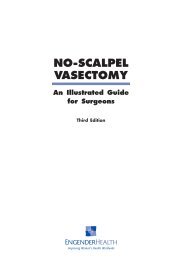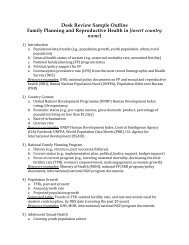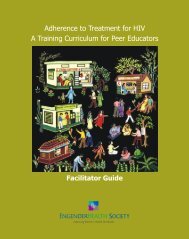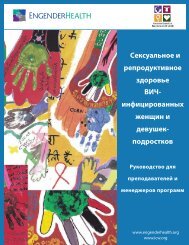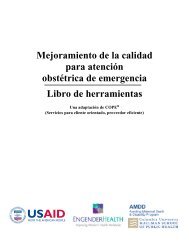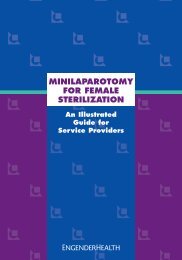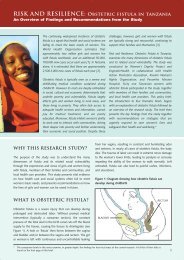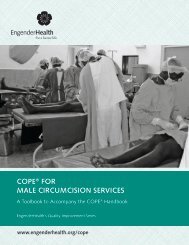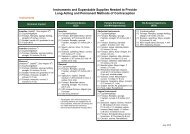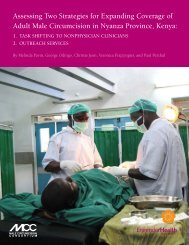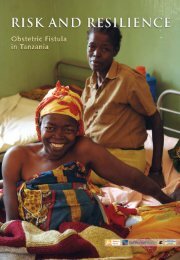Help-Seeking Pathways and Barriers for ... - EngenderHealth
Help-Seeking Pathways and Barriers for ... - EngenderHealth
Help-Seeking Pathways and Barriers for ... - EngenderHealth
Create successful ePaper yourself
Turn your PDF publications into a flip-book with our unique Google optimized e-Paper software.
2. Local Government Authorities<br />
Tanzania has a decentralized, multi-sectoral governance system which extends from the<br />
village to the regional level. While Tanzania has a long history of local governance, the<br />
current system is relatively new, based largely on the CCM election manifesto (1995) <strong>and</strong><br />
the Local Government Re<strong>for</strong>m Agenda (1996). According to a GoT policy paper on local<br />
government re<strong>for</strong>m, LGAs have the following responsibilities: “social development <strong>and</strong><br />
public service provision within their jurisdiction, facilitation of maintenance of law <strong>and</strong> order<br />
<strong>and</strong> issues of national importance such as education, health, water, roads <strong>and</strong> agriculture.”<br />
The discussion here includes only LGAs responsible <strong>for</strong> the direct provision of social services.<br />
Survivors of violence turn to their local leaders primarily <strong>for</strong> advice, referrals (within the<br />
local government hierarchy as well as to healthcare facilities), <strong>and</strong> marital reconciliation<br />
services. In addition, some officials provide “temporary shelters,” although these are<br />
in<strong>for</strong>mal arrangements that often pose risk to both the survivor <strong>and</strong> provider (see subsection<br />
5 below <strong>for</strong> more details). The system is clearly structured; the entry point <strong>for</strong> a<br />
help seeker is often the lowest-level representative, the Ten Cell Leader, who is selected<br />
from among a cluster of ten houses (more common in rural areas). While Ten Cell leaders<br />
were often cited as resource points <strong>for</strong> GBV services during the interviews, they are typically<br />
considered to be “in<strong>for</strong>mal” sources of support. As the hierarchy suggests, Ten Cell leaders<br />
offer the most basic level of care. If a help seeker is unsatisfied with the recommendations<br />
given by the Ten Cell leader, she can begin the process of appealing up the chain (with<br />
referral letters required at each step) 17 —to the village (Village Executive Officer or Street<br />
Leader in urban areas), ward (Ward Executive Officer <strong>and</strong> Ward-level Community<br />
Development Officer) <strong>and</strong> district levels (Social Welfare Officer). As one moves through the<br />
system, the LGAs become more powerful in terms of negotiating settlements, m<strong>and</strong>ating<br />
payments (e.g., to compensate a woman whose property has been destroyed, or as a token<br />
reparation <strong>for</strong> the violence, <strong>for</strong> example, giving the survivor a khanga or kitenge 18 ), <strong>and</strong><br />
requiring an alleged perpetrator to attend reconciliation sessions. This process is<br />
summarized in Table 2.<br />
17 While women may occasionally receive assistance from an LGA without a referral letter, in general, this<br />
hierarchy is respected <strong>and</strong> the established protocol is followed. Without a referral letter, a higher-level<br />
official will offer services only if adequate justification can be given <strong>and</strong> extenuating circumstances<br />
presented.<br />
18 The khanga <strong>and</strong> kitenge are traditional printed cotton garments worn by women wrapped around the<br />
chest or waist, over the head as a headscarf, or used as a baby sling.<br />
<strong>Help</strong>-<strong>Seeking</strong> <strong>Pathways</strong> <strong>and</strong> <strong>Barriers</strong> <strong>for</strong> Survivors of GBV in Tanzania March 2013<br />
Page 26



